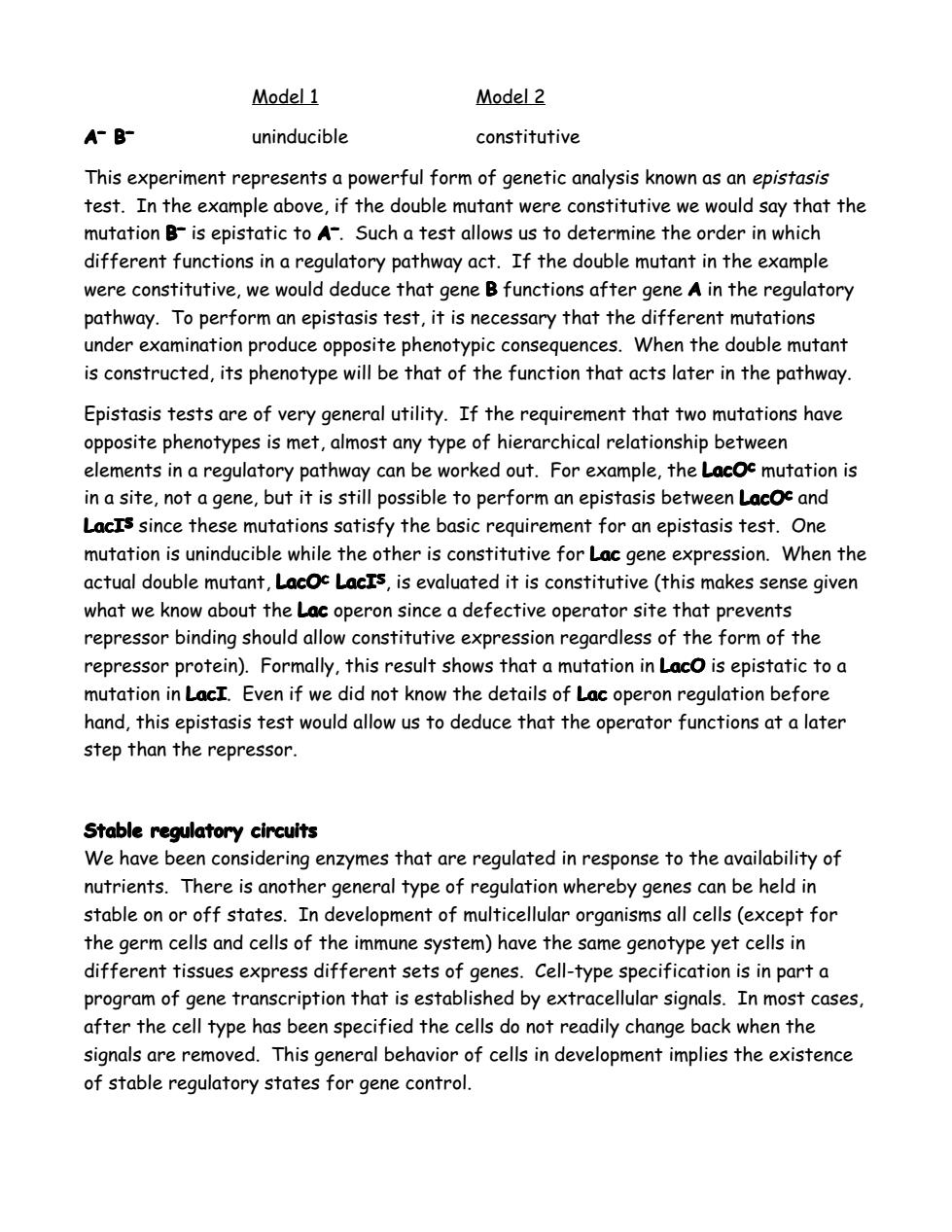正在加载图片...

Model 1 Model2 A-B- uninducible constitutive This experiment represents a powerful form of genetic analysis known as an epistasis test.In the example above,if the double mutant were constitutive we would say that the mutation B-is epistatic to A-.Such a test allows us to determine the order in which different functions in a regulatory pathway act.If the double mutant in the example were constitutive,we would deduce that gene B functions after gene A in the regulatory pathway.To perform an epistasis test,it is necessary that the different mutations under examination produce opposite phenotypic consequences.When the double mutant is constructed,its phenotype will be that of the function that acts later in the pathway. Epistasis tests are of very general utility.If the requirement that two mutations have opposite phenotypes is met,almost any type of hierarchical relationship between elements in a regulatory pathway can be worked out.For example,the LacOc mutation is in a site,not a gene,but it is still possible to perform an epistasis between Lacoc and LacIs since these mutations satisfy the basic requirement for an epistasis test.One mutation is uninducible while the other is constitutive for Lac gene expression.When the actual double mutant,Lacoc LacIs,is evaluated it is constitutive (this makes sense given what we know about the Lac operon since a defective operator site that prevents repressor binding should allow constitutive expression regardless of the form of the repressor protein).Formally,this result shows that a mutation in Laco is epistatic to a mutation in LacI.Even if we did not know the details of Lac operon regulation before hand,this epistasis test would allow us to deduce that the operator functions at a later step than the repressor. Stable regulatory circuits We have been considering enzymes that are regulated in response to the availability of nutrients.There is another general type of regulation whereby genes can be held in stable on or off states.In development of multicellular organisms all cells (except for the germ cells and cells of the immune system)have the same genotype yet cells in different tissues express different sets of genes.Cell-type specification is in part a program of gene transcription that is established by extracellular signals.In most cases, after the cell type has been specified the cells do not readily change back when the signals are removed.This general behavior of cells in development implies the existence of stable regulatory states for gene control.Model 1 Model 2 A–B– uninducible constitutive This experiment represents a powerful form of genetic analysis known as an epistasis test. In the example above, if the double mutant were constitutive we would say that the mutation B– is epistatic to A–. Such a test allows us to determine the order in which different functions in a regulatory pathway act. If the double mutant in the example were constitutive, we would deduce that gene B functions after gene A in the regulatory pathway. To perform an epistasis test, it is necessary that the different mutations under examination produce opposite phenotypic consequences. When the double mutant is constructed, its phenotype will be that of the function that acts later in the pathway. Epistasis tests are of very general utility. If the requirement that two mutations have opposite phenotypes is met, almost any type of hierarchical relationship between elements in a regulatory pathway can be worked out. For example, the LacOc mutation is in a site, not a gene, but it is still possible to perform an epistasis between LacOc and LacIs since these mutations satisfy the basic requirement for an epistasis test. One mutation is uninducible while the other is constitutive for Lac gene expression. When the actual double mutant, LacOcLacIs, is evaluated it is constitutive (this makes sense given what we know about the Lac operon since a defective operator site that prevents repressor binding should allow constitutive expression regardless of the form of the repressor protein). Formally, this result shows that a mutation in LacO is epistatic to a mutation in LacI. Even if we did not know the details of Lac operon regulation before hand, this epistasis test would allow us to deduce that the operator functions at a later step than the repressor. Stable regulatory circuits We have been considering enzymes that are regulated in response to the availability of nutrients. There is another general type of regulation whereby genes can be held in stable on or off states. In development of multicellular organisms all cells (except for the germ cells and cells of the immune system) have the same genotype yet cells in different tissues express different sets of genes. Cell-type specification is in part a program of gene transcription that is established by extracellular signals. In most cases, after the cell type has been specified the cells do not readily change back when the signals are removed. This general behavior of cells in development implies the existence of stable regulatory states for gene control